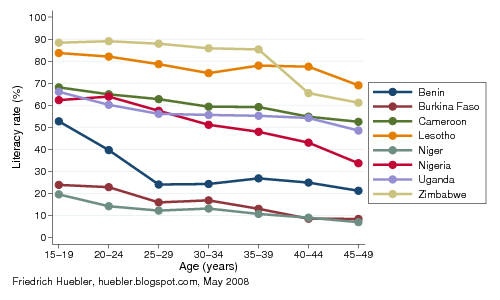The UNESCO Institute for Statistics (UIS) has released the data from its latest survey of international education indicators, conducted in 2007. The UIS Data Centre offers annual data for 208 countries and territories from the years 1999 to 2007. The previous survey had data for 207 countries and territories but starting in 2008, Serbia and Montenegro are listed separately, after both countries had declared their independence in 2006.
The graph below presents the distribution of the latest UIS data for two official Millennium Development Goal indicators, the primary school net enrollment rate (NER) and the survival rate to the last grade of primary school.
The primary NER is available for 178 countries. In 121 countries, the latest data is from 2006. For 10 countries - Egypt, Ethiopia, Ghana, Kazakhstan, Marshall Islands, Saint Kitts and Nevis, Sao Tome and Principe, Serbia, South Korea, and Vanuatu - the primary NER in 2007 is available.
The survival rate to the last grade of primary school is available for 157 countries. To calculate this indicator, data from two consecutive years is needed. For this reason, the latest available data for 88 of the 157 countries is from 2005. For 6 countries - Egypt, Ethiopia, Kazakhstan, Sao Tome and Principe, South Korea, and Tanzania - the survival rate for 2006 is provided in the UIS database.
Distribution of latest national data from UIS education survey 2007

Source: UNESCO Institute for Statistics, Data Centre, May 2008
Related articles
Permanent URL: http://huebler.blogspot.com/2008/05/uis.html
The graph below presents the distribution of the latest UIS data for two official Millennium Development Goal indicators, the primary school net enrollment rate (NER) and the survival rate to the last grade of primary school.
The primary NER is available for 178 countries. In 121 countries, the latest data is from 2006. For 10 countries - Egypt, Ethiopia, Ghana, Kazakhstan, Marshall Islands, Saint Kitts and Nevis, Sao Tome and Principe, Serbia, South Korea, and Vanuatu - the primary NER in 2007 is available.
The survival rate to the last grade of primary school is available for 157 countries. To calculate this indicator, data from two consecutive years is needed. For this reason, the latest available data for 88 of the 157 countries is from 2005. For 6 countries - Egypt, Ethiopia, Kazakhstan, Sao Tome and Principe, South Korea, and Tanzania - the survival rate for 2006 is provided in the UIS database.
Distribution of latest national data from UIS education survey 2007

Source: UNESCO Institute for Statistics, Data Centre, May 2008
Related articles
- UNESCO releases data from 2006 education survey
- Final release of data from UNESCO's 2005 education survey
- Pupil/teacher ratio in primary school
- Global Education Digest 2007
- Global Education Digest 2006
- Global Education Digest 2005
- UIS announcement of data from 2007 education survey
- UNESCO Institute for Statistics (UIS)
- UIS Data Centre
- UN Millennium Development Goals
Permanent URL: http://huebler.blogspot.com/2008/05/uis.html








